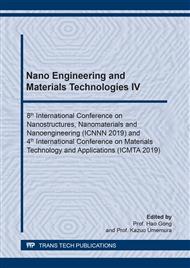p.283
p.291
p.296
p.302
p.306
p.312
p.318
p.325
p.330
Growth of less than 20 nm SnO Nanowire Using AAO Template for Gas Sensing
Abstract:
Large-scale stannous oxide (SnO) nanowires were synthesized via a template and catalyst-free thermal oxidation process. After annealing Sn nanowires embedded AAO template in atmosphere, we observed a large scale of SnO nanowires. SnO nanowires were first prepared via the electrochemical deposition and an oxidization method based on an AAO template. The preparation of SnO nanowires use aluminum sheet (purity 99.999%) and then two-step anodization procedure to obtain raw alumina mold. Finally, transparent alumina mold (AAO template) were obtained by the reaming, soaking with phosphoric acid for 20 minutes and a stripping process. We get a pore size of < 20 nm transparent alumina mold. In order to electroplating needs, we produce platinum film on the bottom surface of AAO template by using sputtering method as the electrode of electroplating deposition. The structure was characterized by X-ray diffraction (XRD). High resolution transmission electron microscopy (HRTEM) and field emission scanning electron microscopy (FESEM) with x-ray energy dispersive spectrometer (EDS) was used to observe the morphology. The EDS spectrum showed that components of the materials are Sn and O. FE-SEM results show the synthesized SnO nanowires to have an approximate length of ~ 10 - 20 μm with a highly aspect ratio > 500. SnO nanowires with an Sn/O atomic ratio of ~ 1 : 1 were observed from EDS. The crystal structure of SnO nanowires showed that all the peaks within the spectra can be indexed to SnO with a tetragonal structure. This studies may lead to the use of the 1D structure nanowires into electronic nanodevices and/or sensors, thus leading to nanobased functional structures.
Info:
Periodical:
Pages:
325-329
Citation:
Online since:
May 2020
Authors:
Keywords:
Price:
Сopyright:
© 2020 Trans Tech Publications Ltd. All Rights Reserved
Share:
Citation:


